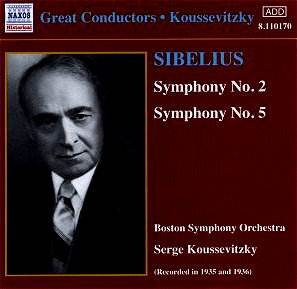Koussevitsky is renowned as a Sibelian. He, with Olin
Downes, was a staunch champion of the Finn and after the death of Kajanus
the UK Sibelius Society turned to Koussevitsky and Beecham to continue
the symphonies on record. He was also said to be amongst the most resolute
in the pursuit of the finally aborted Eighth Symphony; mind you many
people claimed to be dedicated pursuers of that particular grail.
Koussevitsky is not to be easily dismissed in Sibelius
however in the Second Symphony he equates sonority with a broad approach
to tempi and I do not feel that he keeps up the whipcrack tension in
the same way that say Beecham and Barbirolli (Chesky/RPO) do. This for
me almost recalls the Okko Kamu version on DG. The sonority of the Boston
violins and their clean articulation do impress as in the third and
fourth movements. Still and all, the over-pointed and overly deliberate
pace of the finale do not work for me.
Almost two years later and things improve a notch or
two for the Fifth Symphony although tempi become far too expansive in
the finale which needs a far more weighty swing than it gets here. If
you like your Sibelius very broad then this is for you. The tension
is stepped up at various points as at 5.58 in the first movement where
I have not previously heard the whispered icy strings driven with such
tension. Koussevitsky proves himself a master-builder in the heroic
tolling statements at 0714 (first movement). In the second movement
he is a shade too deliberate - almost four square. The brass irruptions
do not have the mordant grip of the most vital accounts.
I should mention that Mark Obert-Thorn's documentation
gives the provenance of these recordings as Red Seal Scroll (2) and
Victor Gold label (5). The latter is slightly quieter in terms of background
burble. Oddly enough it seemed marginally to have intrinsically less
aural bite than the recording of the second.
I did a few spot checks with the 1990 Pearl 2CD set
(GEMM CDS 9408 - bronzed but still playing without problem at least
in the sample tracks I tried) which has the Boston Symphony and Koussevitsky
in the same two symphonies plus Swanwhite, Tapiola and
Pohjola's Daughter. This is with the famous Koussevitsky version
of Symphony No 7 (BBC Symphony). Once again the restoration engineer
was Mark Obert-Thorn. The end result was very similar except that the
speckling of small and vestigial clicks and crackles has been adeptly
stripped out in the Naxos transfer.
Superior documentation, as usual, from Naxos and the
authors are Ian Julier and Mark Obert-Thorn.
Mark Obert-Thorn has done well by the original material
wisely leaving alone the eminently ignorable gentle burble of surface
noise. The immediacy is completely uncompromised.
I have high hopes that Naxos might look at the rare
Sibelius on LP and 78. The early 1950s Rozhdestvensky and Hannikainen
on Melodiya should be worth looking out as should the Ormandy Minneapolis
1 and Kurt Sanderling's Sibelius with the Leningrad Phil on Melodiya.
Rob Barnett


